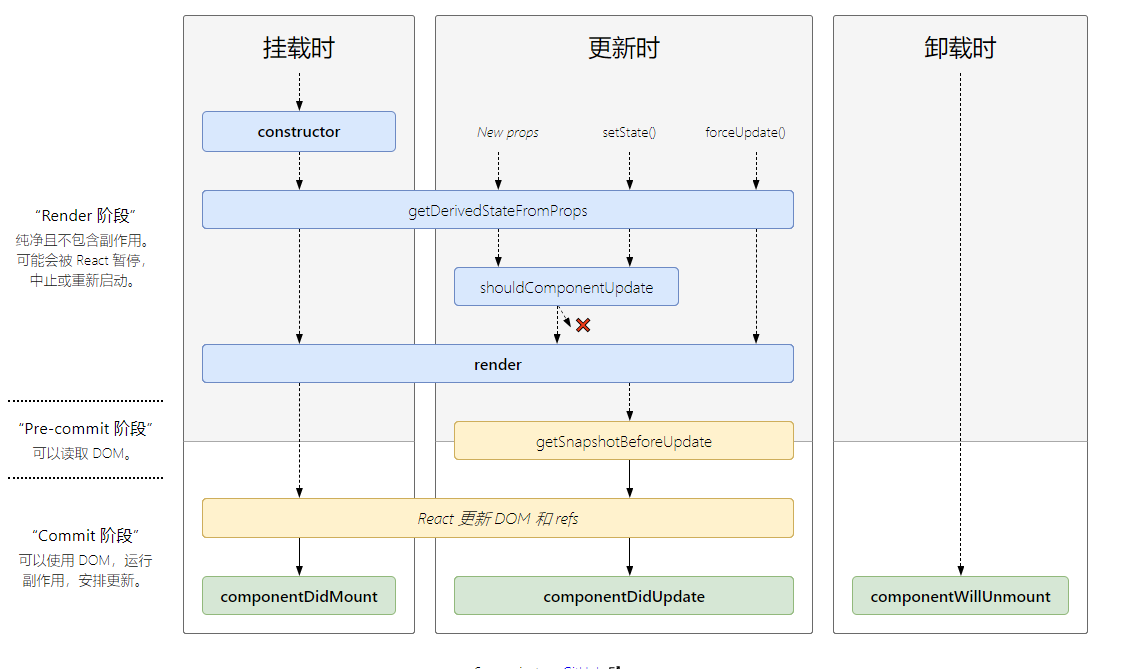React生命周期
React版本 16.13.1生命周期
constructor(props)
componentWillMount() ===> UNSAFE_componentWillMount()
render()
componentDidMount()
componentWillReceiveProps(nextProps) ===> UNSAFE_componentWillReceiveProps
shouldComponentUpdate(nextProps, nextState)
componentWillUpdate(nextProps, nextState) ===> UNSAFE_componentWillUpdate
componentDidUpdate(prevProps, prevState, snapshot)
componentWillUnmount()
componentDidCatch新的生命周期函数
static getDerivedStateFromProps(nextProps, prevState)
static getDerivedStateFromError()
getSnapshotBeforeUpdate()
constructor(props)
在 React 组件挂载之前,会调用它的构造函数。在这里可以进行state的初
始化操作和为事件处理函数绑定实例componentWillMount()
在挂载之前被调用。它在 render() 之前调用,因此在此方法中同步调用 setState() 不会触发额外渲染
此方法是服务端渲染唯一会调用的生命周期函数
React 16.3版本中引入UNSAFE_componentWillMount别名
React 16.X版本中采用componentWillMount()会产生警告警告
React 17.0版本删除 componentWillMount()render()
render() 方法是 class 组件中唯一必须实现的方法。
通过createElement方法返回对应类型的react渲染数据对象
render() 函数应该为纯函数,不能够有副作用
componentDidMount()
在组件挂载后(插入 DOM 树中)立即调用,在此处可以进行一些AJXA、DOM获取、订阅等副作用的操作
componentWillReceiveProps(nextProps)
在已挂载的组件接收新的 props 之前被调用
在挂载过程中不会调用,在组件props改变时候才会触发,内部this.state的改变不会触发componentWillReceiveProps()
React 16.3版本中引入UNSAFE_componentWillReceiveProps别名
React 16.X版本中采用componentWillReceiveProps()会产生警告警告
React 17.0版本删除 componentWillReceiveProps()shouldComponentUpdate(nextProps, nextState)
当 props 或 state 发生变化时,shouldComponentUpdate 会在渲染执行之前被调用。返回值默认为 true。首次渲染或使用 forceUpdate() 时不会调用该方法。
根据 shouldComponentUpdate 的返回值,判断 React 组件的输出是否受当前 state 或 props 更改的影响。返回false则当下更改不会影响组件
返回 false 并不会阻止子组件在 state 更改时重新渲染
目前版本 如果 shouldComponentUpdate 返回 false,则不会调用UNSAFE_componentWillUpdate,render 和 componentDidUpdate
在此中可以做是否渲染的优化操作
componentWillUpdate(nextProps, nextState)
当组件收到新的 props 或 state 时,会在渲染之前调用 componentWillUpdate。使用此作为在更新发生之前执行准备更新的机会。初始渲染不会调用此方法。
React 16.3版本中引入UNSAFE_componentWillUpdate别名
React 16.X版本中采用 componentWillUpdate() 会产生警告警告
React 17.0版本删除 componentWillUpdate()componentDidUpdate(prevProps, prevState, snapshot)
在更新后会被立即调用。首次渲染不会执行此方法。
componentWillUnmount()
在组件卸载及销毁之前直接调用。在此方法中执行必要的清理操作,例如,清除 timer,取消网络请求或清除在 componentDidMount() 中创建的订阅等。
componentDidCatch(error, info)
此生命周期在后代组件抛出错误后被调用。
其接受两个参数
1.error 抛出的错误
2.info 带有 componentStack key 的对象,其中包含有关组件引发错误的栈信息。getDerivedStateFromProps(props,state)
getDerivedStateFromProps 会在调用 render 方法之前调用,并且在初始挂载及后续更新时都会被调用。它应返回一个对象来更新 state,如果返回 null 则不更新任何内容。
static getDerivedStateFromProps(props, state)此方法可看做componentWillMount和componentWillReceiveProps的结合,但是有一些区别
1.在此静态方法中无权访问组件实例
2.需要返回一个对象更新state
3.每次渲染前触发此方法,componentWillReceiveProps仅在父组件重新渲染触发
getSnapshotBeforeUpdate(prevProps,PrevState)
getSnapshotBeforeUpdate() 在最近一次渲染输出(提交到 DOM 节点)之前调用。它使得组件能在发生更改之前从 DOM中捕获一些信息(例如,滚动位置)。此生命周期的任何返回值将作为参数传递给 componentDidUpdate()。
getDerivedStateFromError(error)
此生命周期会在后代组件抛出错误后被调用。它将抛出的错误作为参数,并返回一个值以更新 state
static getDerivedStateFromError(error) {
// 更新 state 使下一次渲染可以显降级 UI
return { hasError: true };
}生命周期执行流程

